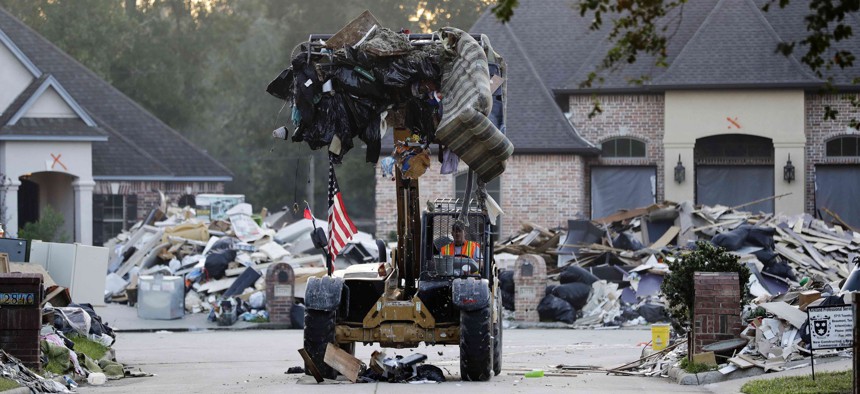Despite Mitigation Efforts, Watchdog Finds Rise in Repeatedly Flooded Properties

A worker cleans up debris in a neighborhood flooded by Hurricane Harvey in Beaumont, Texas, Tuesday, Sept. 26, 2017. AP Photo/David Goldman
The Government Accountability Office says steps like acquiring and demolishing flood-prone homes won't be enough to shore up the finances of the National Flood Insurance Program.
The federal government has spent billions of dollars during the past 30 years on flood mitigation projects, including acquiring and demolishing property in flood zones, elevating structures so they’ll be up above floodwaters, and flood proofing buildings in other ways.
But in spite of these efforts, a new government watchdog report says that the number of properties hit with flood damage on more than one occasion has grown over the past decade. It also notes that the National Flood Insurance Program premium prices that property owners pay do not fully reflect flood hazards for insured property, leaving the federal government financially exposed to this risk.
“Addressing this imbalance would mean reducing the flood risk of the insured properties, increasing premium revenue, or some combination of both,” the Government Accountability Office report says. It adds that, “mitigation alone will not be sufficient to resolve NFIP’s financial challenges; structural reforms to the program’s premium rates will also be necessary.”
The financial shortfalls bedeviling the flood insurance program are well documented. A key concern with raising premiums is that rates could become unaffordable for many homeowners and could even set off waves of foreclosures in communities where people are already struggling financially.
To bridge the gap between costs and revenues in the program, the Federal Emergency Management Agency has borrowed about $36 billion from the Treasury to pay claims during disasters over the past 15 years or so. Congress cancelled $16 billion of this “debt” in 2017, but about $20 billion remains outstanding.
Looming over the program is climate change and the specter of worse storms and more intense flooding in the years ahead.
Data presented in the GAO report shows how claims paid per policy haven’t grown gradually over the years, but instead have had sizable spikes in years when extreme flooding occurs, like when Hurricanes Harvey, Irma and Maria struck in 2017.
Between 1989 and 2018, GAO says that FEMA spent about $5.4 billion on flood mitigation programs, with property acquisitions accounting for about 75% of this spending, and most of the remaining sum going toward elevating structures. (The dollar figure does not include state and local cost-share spending on these programs.)
During that same timeframe, FEMA undertook mitigation projects at more than 57,000 properties, including more than 46,000 buyouts.
Yet from 2009 to 2018, the number of properties where no flood mitigation measures had been taken, but that experienced repeated flooding, grew by 44,618—the GAO report says this is more than double the number of repetitive loss properties that underwent some kind of flood mitigation during that time.
Repetitive loss properties here generally refer to those that have flooded at least twice in 10 years. The states with the most repeatedly flood-damaged properties between 1989 and 2018 included: Louisiana (38,406), Texas (36,666) and Florida (20,443), according to the report.
It also notes that, of the $69.7 billion in claims the flood insurance program paid out between 1978 and 2019, about $22 billion was for properties damaged by flooding more than once.
A full copy of the GAO report can be found here.
Bill Lucia is a senior reporter for Route Fifty and is based in Olympia, Washington.
NEXT STORY: Fire Departments Anticipate Busy Fourth of July as Fireworks Sales Skyrocket






